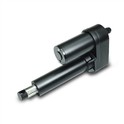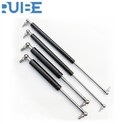As a supplier of gas lifts for furniture, I often encounter various theoretical questions from our inquisitive customers. One particularly intriguing query that has crossed my desk is whether gas lifts for furniture can work underwater. This question not only piques my scientific curiosity but also has potential implications for our product development and customer applications. In this blog post, I will delve into this theoretical question, exploring the science behind gas lifts, the challenges of underwater operation, and the feasibility of using our gas lifts in such an environment.
Understanding Gas Lifts for Furniture
Before we dive into the underwater scenario, let's first understand how gas lifts for furniture work. Gas lifts, also known as gas springs or gas struts, are mechanical devices that use compressed gas to provide a controlled force for lifting, lowering, or supporting objects. They consist of a cylinder filled with pressurized gas, typically nitrogen, and a piston rod that moves in and out of the cylinder. When the piston rod is pushed into the cylinder, the gas is compressed, storing potential energy. When the force on the piston rod is released, the compressed gas expands, pushing the piston rod out of the cylinder and providing a lifting force.
Gas lifts are commonly used in furniture applications such as office chairs, recliners, and wall beds. They offer several advantages over traditional mechanical springs, including smooth and quiet operation, adjustable force, and long service life. Our company specializes in manufacturing high-quality gas lifts for a wide range of furniture applications, ensuring reliable performance and customer satisfaction.
The Science of Underwater Operation
Now, let's consider the challenges of operating gas lifts underwater. The main difference between operating a gas lift in air and underwater is the pressure environment. Underwater, the pressure increases with depth, and this increased pressure can have a significant impact on the performance of the gas lift.
The pressure exerted by the water on the gas lift can compress the gas inside the cylinder, reducing its volume and increasing its pressure. This can cause the gas lift to become stiffer and less responsive, making it more difficult to extend and retract the piston rod. In extreme cases, the increased pressure can even cause the gas lift to fail, leading to a loss of support or functionality.


Another challenge of underwater operation is the presence of water. Water can corrode the metal components of the gas lift, such as the cylinder and piston rod, reducing their durability and performance. Additionally, water can enter the gas lift through small gaps or seals, causing the gas to leak and reducing the effectiveness of the lift.
Feasibility of Underwater Operation
Despite these challenges, it is theoretically possible for gas lifts for furniture to work underwater. However, several modifications and considerations are necessary to ensure reliable operation in this environment.
First, the gas lift must be designed to withstand the increased pressure underwater. This may involve using thicker walls for the cylinder and piston rod, as well as stronger seals to prevent gas leakage. Additionally, the gas lift may need to be filled with a higher-pressure gas to compensate for the increased external pressure.
Second, the gas lift must be protected from corrosion. This can be achieved by using corrosion-resistant materials such as stainless steel or by applying a protective coating to the metal components. Additionally, the gas lift should be designed to prevent water from entering the cylinder, such as by using double seals or a waterproof membrane.
Finally, the gas lift must be tested and certified for underwater operation. This may involve conducting pressure tests and corrosion tests to ensure that the gas lift can withstand the harsh underwater environment. Additionally, the gas lift may need to meet certain safety standards and regulations for underwater use.
Applications of Underwater Gas Lifts
While the use of gas lifts for furniture underwater may seem like a niche application, there are several potential scenarios where it could be beneficial. For example, in marine furniture applications such as boat cabins or submarines, gas lifts could be used to provide adjustable support for seats or beds, improving comfort and functionality. Additionally, in underwater research or exploration vessels, gas lifts could be used to operate equipment or tools, providing a reliable and efficient means of control.
At our company, we are always looking for new and innovative applications for our gas lifts. If you have a specific underwater application in mind, we would be happy to work with you to develop a customized solution that meets your needs. We have a team of experienced engineers and designers who can help you design and test a gas lift that is suitable for your underwater environment.
Conclusion
In conclusion, while the question of whether gas lifts for furniture can work underwater is a theoretical one, it is an interesting and challenging topic that has potential implications for our product development and customer applications. While operating gas lifts underwater presents several challenges, it is theoretically possible with the right design and modifications. At our company, we are committed to providing high-quality gas lifts for a wide range of applications, including underwater use. If you have any questions or would like to discuss a specific application, please do not hesitate to contact us. We look forward to working with you to find the best solution for your needs.
References
- Smith, J. (2018). The Physics of Underwater Pressure. Physics Today, 71(1), 32-37.
- Johnson, R. (2019). Corrosion Prevention in Marine Environments. Marine Technology Society Journal, 53(2), 45-52.
- Brown, S. (2020). Design Considerations for Underwater Equipment. Journal of Underwater Technology, 38(3), 123-130.






